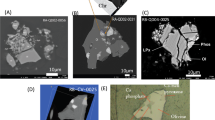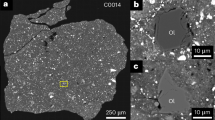Abstract
The composition of the sampled melt rocks at the 22 km diameter E. Clearwater impact structure indicates the presence of ∼8% C-1 material. The meteoritic component is fractionated with refractory siderophiles, up to 30 times C-1 abundances, concentrated in ten to hundred micron-sized, magnetic particles. These particles consist of the Ni-sulphide, millerite, and what is assumed to be a mixture of refractory silicates and magnetite with grain sizes of <1 μm. The larger particles have a core-rim structure with millerite and occasionally very minor galena and possibly pentlandite in the core. An origin as a combination of altered meteoritic metal and condensed meteoritic silicate is favored for the origin of the siderophile-rich particles. If 8% meteoritic material is taken as the average meteoritic contamination in the melt, then the E. Clearwater projectile may have impacted with a velocity of 17 km s−1. Peak shock pressures would have been of the order of 300 GPa, sufficient to vaporize the silicate component but only melt the metal component of the projectile. As the meteoritic material was being driven down into vaporized/ melted target rocks during the initial stages of impact, the melted Fe, Ni metal underwent oxidation, Fe was removed, and meteoritic silicate material recondensed on the cooler, essentially Ni metal. As cavity excavation proceeded, these Ni metal, silicate-oxide particles were incorporated in the melt, their refractory nature prevented thermal digestion and sulphur in the melt reacted with the metal to produce millerite on final equilibration. If this hypothesis is correct, it suggests that the E. Clearwater projectile was a C-2 or C-3 chondrite, both of which are compatible with the trace element composition of the melt rocks. Clearwater Lake is a twin impact structure formed by an asteroid pair. It is still not clear, however, what type of projectile formed the 32 km diameter western structure, where the surface melt rocks contain no identifiable meteoritic signature.
Similar content being viewed by others
References
Ahrens TJ, O'Keefe JD (1972) Shock melting and vaporization of lunar rocks and minerals. Moon 4:214–249
Ahrens TJ, O'Keefe JD (1977) Equations of state and impact-induced shock-wave attenuation on the moon. In: DJ Roddy, RO Pepin, RB Merrill (eds) Impact and Explosion Cratering. Pergamon Press, New York, pp 639–656
Anderson DL, Kanamori H (1968) Shock-wave equations of state for rocks and minerals. J Geophys Res 73:6477–6502
Binzell RP, Van Flandern TC (1979) Minor planets: The discovery of minor satellites. Science 203:903–905
Bostock HH (1969) The Clearwater complex, New Quebec. Geol Surv Canada Bull 178
Brett R (1967) Metallic spherules in impactite and tektite glasses. Am Mineral 52:721–733
Bunch TE, Cassidy WA (1972) Petrographic and electron microprobe study of the Monturaqui impactite. Contrib Mineral Petrol 36:95–112
Butkovich TR (1965) Calculation of the shock wave from an underground nuclear explosion in granite. J Geophys Res 70:885–892
Cherry JT, Petersen FL (1970) Numerical simulation of stress wave propagation from underground nuclear explosions. In: Peaceful Nuclear Explosions, International Atomic Energy Agency, Vienna, pp 241–326
Dence MR (1971) Impact melts. J Geophys Res 76:5552–5565
Dence MR, Innes MJS, Beals CS (1965) On the probable meteorite origin of the Clearwater Lakes, Quebec. JR Astron Soc Canada 59:13–22
Desborough GA, Anderson AT, Wright TL (1968) Mineralogy of sulphides from certain Hawaiian basalts. Econ Geol 63:636–644
Dohnanyi JS (1969) Collisional model of asteroids and their debris. J Geophys Res 74:2531–2554
El Goresy A (1968) The opaque minerals in impactite glasses. In: BM French, NM Short (eds) Shock Metamophism of Natural Materials. Mono Book Corp, Baltimore, pp 531–554
El Goresy A, Chao ECT (1977) Discovery, origin and significance of Fe-Cr-Ni veinlets in the compressed zone of the 1973 Ries research drill core. Geol Bavarica 75:305–322
Fregerslev S, Carstens H (1976) FeNi metal in the impact melt rocks of Lake Lappajärvi, Finland. Contrib Mineral Petrol 55:255–263
Gibbons RV, Hörz F, Thompson TD, Brownlee DE (1976) Metal spherules in Wabar, Monturaqui and Henbury impactites. Proc Lunar Sci Conf 7th, pp 863-880
Göbel F, Reimold U, Baddenhausen H, Palme H (1980) The projectile of the Lappajärvi crater. Z Naturforsch 35a:197–203
Grieve RAF (1975) The petrology and chemistry of the impact melt at Mistastin Lake crater, Labrador. Bull Geol Soc Am 86:1617–1629
Grieve RAF (1978) Meteoritic component and impact melt composition of the Lac à l'Eau Claire (Clearwater) impact structures, Quebec. Geochim Cosmochim Acta 42:429–431
Grieve RAF, Dence MR, Robertson PB (1977) Cratering processes: As interpreted from the occurrence of impact melts. In: DJ Roddy, RO Pepin, RB Merrill (eds) Impact and Explosion Cratering. Pergamon Press, New York, pp 791–814
Horn W, El Goresy A (1980) The Rochechouart crater in France: Stony and not an iron meteorite? In: Lunar Planet Sci XI, Lunar Planet Sci Instit, Houston, pp 468–470
Janssens MJ, Hertogen J, Takahashi H, Anders E, Lambert P (1977) Rochechouart meteorite crater: Identification of projectile. J Geophys Res 82:750–758
Jones EM, Sandford MT (1977) Numerical simulation of a very large explosion at the earth's surface with possible application to tektites. In: DJ Roddy, RO Pepin, RB Merrill (eds) Impact and Explosion Cratering. Pergamon Press, New York, pp 1009–1024
Kelly WR, Holdsworth E, Moore CB (1974) The chemical composition of metallic spheroids and metallic particles within impactites from Barringer Meteor Crater, Arizona. Geochim Cosmochim Acta 38:533–543
Kieffer SW, Simonds CH (1980) The role of volatiles and lithology in the impact cratering process. Rev Geophys Space Phys 18:143–181
Krauskopf K (1967) Introduction to Geochemistry. McGraw-Hill, New York
Kullerud G, Yund RA (1962) The Ni-S system and related minerals. J Petrol 3:126–175
Kullerud G, Yund RA, Moh GH (1969) Phase relations in the Cu-Fe-S, Cu-Ni-S and Fe-Ni-S system. Econ Geol Monograph 4:323–343
Lambert P (1977) The meteoritic contamination in the Rochechouart crater: Statistical geochemical investigations. In: DJ Roddy, RO Pepin, RB Merrill (eds) Impact and Explosion Cratering. Pergamon Press, New York, pp 449–460
Larimer JW (1967) Chemical fractionations in meteorites — I. Condensation of the elements. Geochim Cosmochim Acta 31:1215–1238
Maerz U, Reimold WU, Stöffler D (1979) Preliminary results on the petrography of the Lappajärvi impact melt. In: Lunar Planet Sci X, Lunar Planet Sci Instit, Houston, pp 769–771
Masaitis VL, Sysoev AG (1975) Meteorite matter in the impactites of Popigai crater (in Russian). Lett Astron J 1(4):43–47
Mason B (1963) The carbonaceous chondrites. Space Sci Rev 1:621–646
Mason B (1971) Handbook of elemental abundances in meteorites. Gordon Breach, New York
McQueen RG, Marsh SP, Fritz JN (1967) Hugoniot equation of state of twelve rocks. J Geophys Res 72:4999–5036
Morgan JW, Gros J, Takahashi H, Hertogen J, Janssens MJ (1979) Ries impact crater: Search for meteoritic material. Geochim Cosmochim Acta 43:803–815
Naldrett AJ (1969) A portion of the system Fe-S-O between 900° and 1,080° C and its application to sulphide ore magmas. J Petrol 10:171–201
O'Keefe JD, Ahrens TJ (1977) Impact-induced energy partitioning, melting and vaporization on terrestrial planets. Proc Lunar Sci Conf 8th, pp 3357–3374
Onorato PIK, Uhlmann DR, Simonds CH (1978) Thermal history of Manicouagan impact melt sheet, Quebec. J Geophys Res 83:2789–2798
Palme H, Janssens MJ, Takahashi H, Anders E, Hertogen J (1978) Meteoritic material at five large impact craters. Geochim Cosmochim Acta 42:313–323
Palme H, Göbel E, Grieve RAF (1979) The distribution of volatile and siderophile elements in the impact melt of East Clearwater (Quebec). Proc Lunar Sci Conf 10th, pp 2465–2492
Palme H, Rammensee W, Reimold U (1980) The meteoritic component of impact melts from European impact craters. In: Lunar Planet Sci XI, Lunar Planet Sci Instit, Houston, pp 848–850
Park FR, Reid AM (1964) A comparative study of metallic spherules. Ann New York Acad Sci 119:250–281
Passey QR, Melosh HJ (1980) Effects of atmospheric breakup on crater field formation. Icarus 42:211–233
Phinney WC, Simonds CH, Cochran A, McGee PE (1978) West Clearwater, Quebec impact structure, Part II: Petrology. Proc Lunar Planet Sci Conf 9th, pp 2659–2693
Rambaldi ER (1976) Trace element content of metals from L-group chondrites. Earth Planet Sci Lett 31:224–238
Rambaldi ER (1977a) The contents of Sb, Ge and refractory siderophile elements in metals of L-group chondrites. Earth Planet Sci Lett 33:407–417
Rambaldi ER (1977b) Trace element contents of metals from H and LL — group chondrites. Earth Planet Sci Lett 36:347–358
Ramdohr P (1973) The opaque minerals in stony meteorites. Elsevier, New York
Rehfuss DE (1972) Lunar winds. J Geophys Res 77:6303–6315
Rehfuss DE, Michael D, Anselmo JC, Kincheloe NK (1977) A model for wind extension of the Copernicus ejecta blanket. In: DJ Roddy, RO Pepin, RB Merrill (eds) Impact and Explosion Cratering. Pergamon Press, New York, pp 1123–1132
Reimold WU, Grieve RAF, Palme H (1981) Rb-Sr dating of the impact melt from East Clearwater, Quebec (in preparation)
Shaw DM, Dostal J, Keays RR (1976) Additional estimates of continental surface Precambrian shield composition in Canada. Geochim Cosmochim Acta 40:73–84
Simonds CH, Phinney WC, McGee PE, Cochran A (1978a) West Clearwater impact structure, Part 1: Field geology, structure and bulk chemistry. Proc Lunar Planet Sci Conf 9th, pp 2633–2658
Simonds CH, Floran RJ, McGee PE, Phinney WC, Warner JL (1978b) Petrogenesis of melt rocks, Manicouagan impact structure, Quebec. J Geophys Res 83:2773–2780
Skinner BJ, Peck D (1969) An immiscible sulphide melt from Hawaii. Econ Geol Monograph 4:310–322
Spencer L (1933) Meteoritic iron and silica glass from the meteorite craters of Henbury (Central Australia) and Wabar (Arabia). Mineral Mag 23:387–404
Tanner RW (1963) The orbital perturbations of a very large twin meteorite. J R Astron Soc Canada 57:109–113
Tedesco EF (1979) Binary asteroids: Evidence of their existence from light curves. Science 203:905–907
Wanless RK, Stevens RD, Lachance GR, Rimsaite JYH (1964) Age determinations and geologic studies. Part 1, 1965, isotopic ages, Report 5. Geol Surv Canada Pap 64-17
Wolf R, Woodrow AB, Grieve RAF (1980) Meteoritic material at four Canadian impact structures. Geochim Cosmochim Acta 44:1015–1022
Wood JA (1967) Chondrites: Their metallic minerals, thermal histories and parent planets. Icarus 6:1–49
Author information
Authors and Affiliations
Rights and permissions
About this article
Cite this article
Grieve, R.A.F., Palme, H. & Plant, A.G. Siderophile-rich particles in the melt rocks at the E. Clearwater impact structure, Quebec: Their characteristics and relationship to the impacting body. Contr. Mineral. and Petrol. 75, 187–198 (1981). https://doi.org/10.1007/BF01166759
Received:
Accepted:
Issue Date:
DOI: https://doi.org/10.1007/BF01166759




